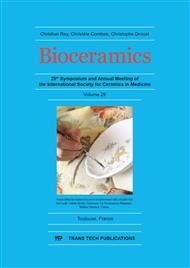[1]
C. Drouet, M. -T. Carayon, C. Combes, C. Rey, Surface enrichment of biomimetic apatites with biologically-active Mg2+ and Sr2+: a preamble to the activation of bone repair materials, Mater. Sci. Eng. C 28 (2008) 1544-1550.
DOI: 10.1016/j.msec.2008.04.011
Google Scholar
[2]
J. Elliott, R. Wilson,S. Dowker, Apatite structures, Adv. X-RayAnal. 45 (2002) 172–181.
Google Scholar
[3]
A Farzadi, F Bakhshi, M Solati-Hashjin, M Asadi-Eydivand, Magnesium incorporated hydroxyapatite: Synthesis and structural properties characterization, Ceramics International 40 (2014), 6021-6029.
DOI: 10.1016/j.ceramint.2013.11.051
Google Scholar
[4]
Boanini E, Torricelli P, Fini M, Sima F, Serban N, Mihailescu IN, Bigi A, Magnesium and strontium doped octacalcium phosphate thin films by matrix assisted pulsed laser evaporation. J Inorg Biochem 107 (2012), 65–72.
DOI: 10.1016/j.jinorgbio.2011.11.003
Google Scholar
[5]
Bracci B, Torricelli P, Panzavolta S, Boanini E, Giardino R, Bigi A, Effect of Mg(2+), Sr(2+), and Mn(2+) on the chemico-physical and in vitro biological properties of calcium phosphate biomimetic coatings, J Inorg Biochem 103 (2009), 1666–1674.
DOI: 10.1016/j.jinorgbio.2009.09.009
Google Scholar
[6]
Cabrejos-Azama J, Alkhraisat MH, Rueda C, Torres J, Blanco L, Lòpez-Cabarcos E, Magnesium substitution in brushite cements for enhanced bone tissue regeneration. Mater Sci Eng C Mat Biol Appl 43 (2014), 403–410.
DOI: 10.1016/j.msec.2014.06.036
Google Scholar
[7]
LT Bang, BD Long, R Othman, Carbonate hydroxyapatite and silicon-substituted carbonate hydroxyapatite: synthesis, mechanical properties, and solubility evaluations, The Scientific World Journal 2014 (2014).
DOI: 10.1155/2014/969876
Google Scholar
[8]
X. Liu, C. Ding, and P. K. Chu, Mechanism of apatite formation on wollastonite coatings in simulated body fluids, Biomaterials 25 (2004), 1755–1761.
DOI: 10.1016/j.biomaterials.2003.08.024
Google Scholar
[9]
Iimori Y, Kameshima Y, Okada K, Hayashi S., Comparative study of apatite formation on CaSiO3 ceramics in simulated body fluids with different carbonate concentrations, J Mater Sci Mater Med. 16 (2005), 73-79.
DOI: 10.1007/s10856-005-6449-x
Google Scholar
[10]
Pietak A M, Reid J W, Stott M J, Sayer M, Silicon substitution in the calcium phosphate bioceramics, Biomaterials 28 (2007), 4023-4032.
DOI: 10.1016/j.biomaterials.2007.05.003
Google Scholar
[11]
Gervaso F, Sanosh KP, Scalera F, Sannino A, Licciulli A, Mechanical stability of highly porous hydroxyapatite scaffolds during different stages of in vitro studies, Materials Letters 185 (2016), 239-242.
DOI: 10.1016/j.matlet.2016.08.139
Google Scholar
[12]
Scalera F, Gervaso F, Sanosh KP, Sannino A, Licciulli A, Influence of the calcination temperature on morphological and mechanical properties of highly porous hydroxyapatite scaffolds, Ceramics International 39 (2013), 4839-4846.
DOI: 10.1016/j.ceramint.2012.11.076
Google Scholar
[13]
Gervaso F, Scalera F, Kunjalukkal Padmanabhan S, Sannino A, Licciulli A, High-Performance Hydroxyapatite Scaffolds for Bone Tissue Engineering Applications. International Journal of Applied Ceramic Technology 9 (2012), 507-516.
DOI: 10.1111/j.1744-7402.2011.02662.x
Google Scholar


